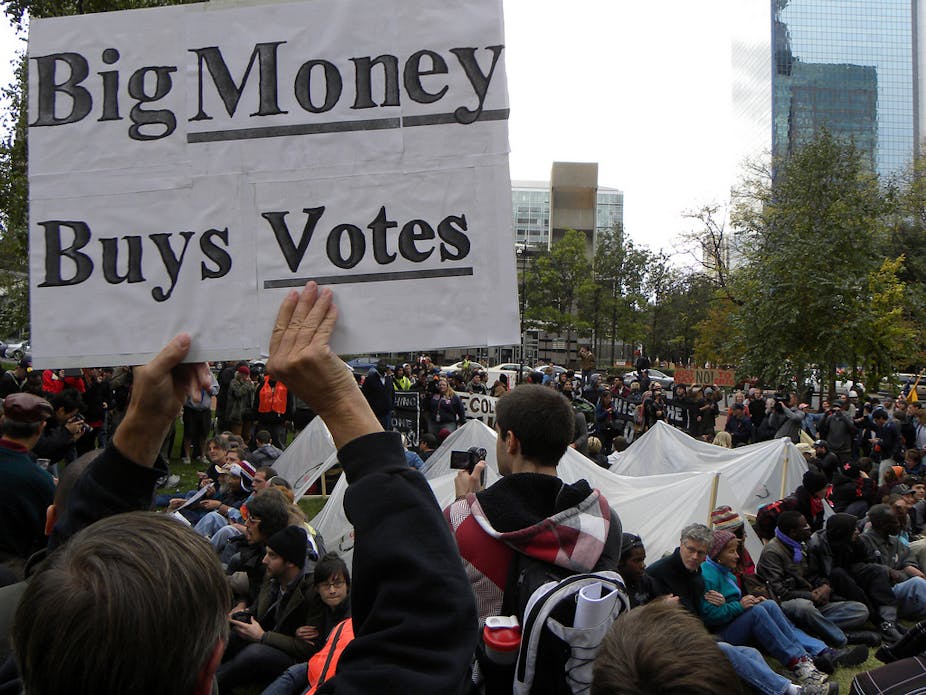At a time when the “Occupy Wall Street” protests against corporate greed are proliferating in the United States and around the world, it’s ironic to read the floating of yet another corporate “get-even-more rich” scheme, this time related to Australian health care.
Deloitte Access Economics director Lynne Pezzullo has apparently been busy lobbying senior federal bureaucrats to create employer or self-funded health savings accounts (HSAs) like the present superannuation scheme.
The federal government would make co-contributions to the health accounts of low-income workers and the public hospital system would remain free only for delivery of emergency or essential health services.
Pezzulo claims the rationale for this comes from the fact that health spending has already risen to almost 10% of GDP, and because of the rapid growth of the health-care intensive 65-plus demographic.
Striking while the iron’s hot
Such proposals must be taken seriously in the present volatile political context where vested interests of many shapes and forms are jostling for policy traction, says Pezzulo.
Similarly, the pharmaceutical lobby group Medicines Australia has previously advocated a Medicines Savings Account (MSA) to replace the federal government’s cost-effectiveness and subsidy system under the referendum-supported Pharmaceutical Benefits Scheme (PBS).
Pezzulo’s proposal draws upon examples of HSAs and MSAs in Singapore, South Africa, China and the United States.
These systems forcibly encourage citizens (called “consumers”) to jog, watch their diet, be compliant with medications and trade off disposable income so they can build up cash (that HSA and MSA funds invest in the stockmarket) for that “rainy day” when they are, for example, diagnosed with cancer, ischemic heart disease or hit by a bus.
Translated into “economics speak,” HSAs and MSAs purport to address major inefficiencies of health-care systems dominated by private health insurance.
These systems already abound with moral hazard (lack of incentive for healthy behaviour); escalating costs (premiums increase each year by 2% to 3% above the inflation rate); adverse selection (older people in smaller insurance pools) and; gaps in coverage (the poor and unemployed generally lack private health insurance).
Case study: Singapore
Since 1984, the government of Singapore has implemented an HSA scheme whereby employees and self-employed citizens must contribute 6% to 8% of their monthly salary to a personal Medisave account for costs of hospitalization and medical expenses.
Such contributions are tax-deductible and earn interest. Withdrawals require authorization and cash co-payment, particularly from patients choosing more expensive procedures or private hospitals.
Ostensibly to foster equity, Singaporean Medisave is complemented by the somewhat duplicitously named MediShield, a non-compulsory, catastrophic or prolonged illness insurance scheme, and the Medifund safety net to help the poor pay for hospital medical care.
Medisave allows the Singaporean government to boast its contribution to health-care costs is only 3.3% of GDP.
This makes the situation in Singapore sound like things are under great fiscal control. But that’s only until we start to look at the detail and wider implications of this kind of health-care system.
Increasing inequity
In Singapore, three quarters of health-care costs are paid directly by citizens to private corporations instead of to their government as taxes.

What’s more, the experience with HSAs and MSAs in Singapore, South Africa, the United States and China over the last 20 years is that increasing numbers of people forego necessary and preventive care, often because they lack the experience, information or ability to call upon their HSA or MSA.
Meanwhile, fund managers increase profits by finding reasons to deny access. The insurance risk pool is depleted and those with higher risks are saddled with higher premiums.
Those who are uninsured (through unemployment, disability or poverty) are forced into rationed second-tier health care, eroding foundational social virtues such as justice and equity.
HSAs and MSAs provide personal financial windfalls to the investing fund managers and wealthy citizens who benefit from tax deductions.
They increase likelihood of fraudulent misappropriation, inappropriately high administrative costs and vulnerability to stock market volatility.
Medical bills, for instance, cause over 60% of personal bankruptcies in the United States.
Figures and facts
Nations that experimented with HSAs and MSAs in the heady days of financial deregulation in the 1980s and 1990s, are now realizing that health-care cost reductions are more efficiently organised through direct government intervention (to ration health services or providers) as well as universal coverage taxpayer-funded health-care systems.
World Health Organisation (WHO) and OECD’s 2008 estimates place health-care costs as percentage of GDP at 10% in Canada; 8.4% in the United Kingdom; 11% in France and; 8.9% in Australia.
Compare this to 17% of GDP in the corporatized U.S system.
These figures alone disprove the lobbyists’ frequent contention that the free market operates health-care more efficiently than governments.
As do the number of huge anti-fraud claims that have been recovered against private corporations involved in health care in the United States.
Asking Australians whether our universal coverage healthcare and medicines system is sustainable is like asking whether our police, primary and high school education system and military are sustainable.
That any government could claim a policy triumph by forcing citizens to fund health care individually, to basically tax to a corporate roulette wheel of stockmarket investment ten percent of their disposable income instead of to the political organisation supposed to represent their interests, highlights exactly what the “Occupy Wall Street” protestors are on about.

